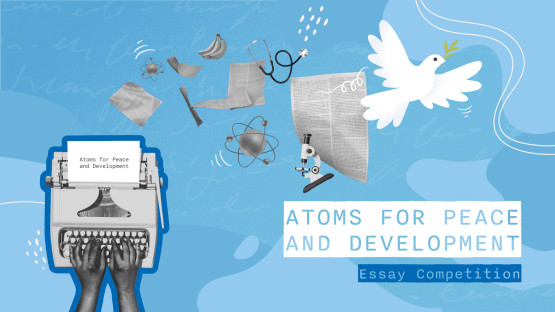The winner is 20-year-old Nela Gawrychowska, who took inspiration from the words of Eisenhower and two-time Nobel prize-winner Marie Skłodowska-Curie to outline her thoughts on fusion energy, writing that it could become “a potential catalyst for a sustainable, prosperous, and inclusive future".
An honourable mention goes to 20-year-old Mahek Arora, who wrote about the role of nuclear science and technology and its potential to “foster peace, prosperity and cooperation on a global scale”.
Writers who decided to enter the competition, open to anyone aged 18-24, were encouraged to take inspiration from Eisenhower’s vision and posit ways the IAEA and the international community could address today’s biggest challenges within the mission of “Atoms for Peace and Development”.
The essays submitted were informed by numerous aspects of the IAEA’s work, from safeguards to supporting low-carbon nuclear energy. The most original essays also came up with ways peaceful uses of nuclear science and technology could play an even greater part in promoting peace, climate change mitigation and adaptation, health, and food and energy security.
Giving younger generations a voice
“This competition has given young people from around the world the chance to use their voices, and for us to hear what is important to them,” said IAEA Director General Rafael Mariano Grossi.
“Many of the writers chose themes that go right to the heart of the IAEA’s work; subjects like nuclear energy and radiotherapy,” the Director General said. “Reading the finalists’ essays and speeches gave me new insight into how they see the IAEA and what they hope, and expect, from us in the future,” he said.
This year, the IAEA has been marking the anniversary of Eisenhower’s speech and the enduring impact of his vision for peace. In September, the Agency and the United States of America hosted a panel discussion at the Albertina Museum in Vienna on the margins of the IAEA’s 67th General Conference. The President of Ghana Nana Akufo-Addo, the US Secretary of Energy Jennifer Granholm and Susan Eisenhower, granddaughter of President Eisenhower, joined IAEA Director General Rafael Mariano Grossi to discuss the legacy of the speech and the impact of the IAEA.
Since Eisenhower gave his 1953 speech, the IAEA has assisted its Member States, now numbering 178, in widening access to life-affirming uses of nuclear science and technology. Millions of people have benefited from initiatives such as the IAEA’s Rays of Hope initiative, which increases access to cancer care in middle- and low-income countries, and from the IAEA’s work supporting countries in their efforts to adapt to the devastating consequences of climate change on agriculture, the ocean and fresh water resources. For the world to harness fully the many peaceful uses of nuclear science and technology, safety, security and safeguards must come first. Here too, the IAEA plays a central role.
In the words of competition winner Gawrychowska , “If I were to articulate a singular wish, it would undeniably be for every individual to taste peace and to recognize it as a treasure beyond measure. It stands as our most invaluable asset — a bedrock for sustainable progress and an imperative for the responsible harnessing of the potential hidden within the atom.”



